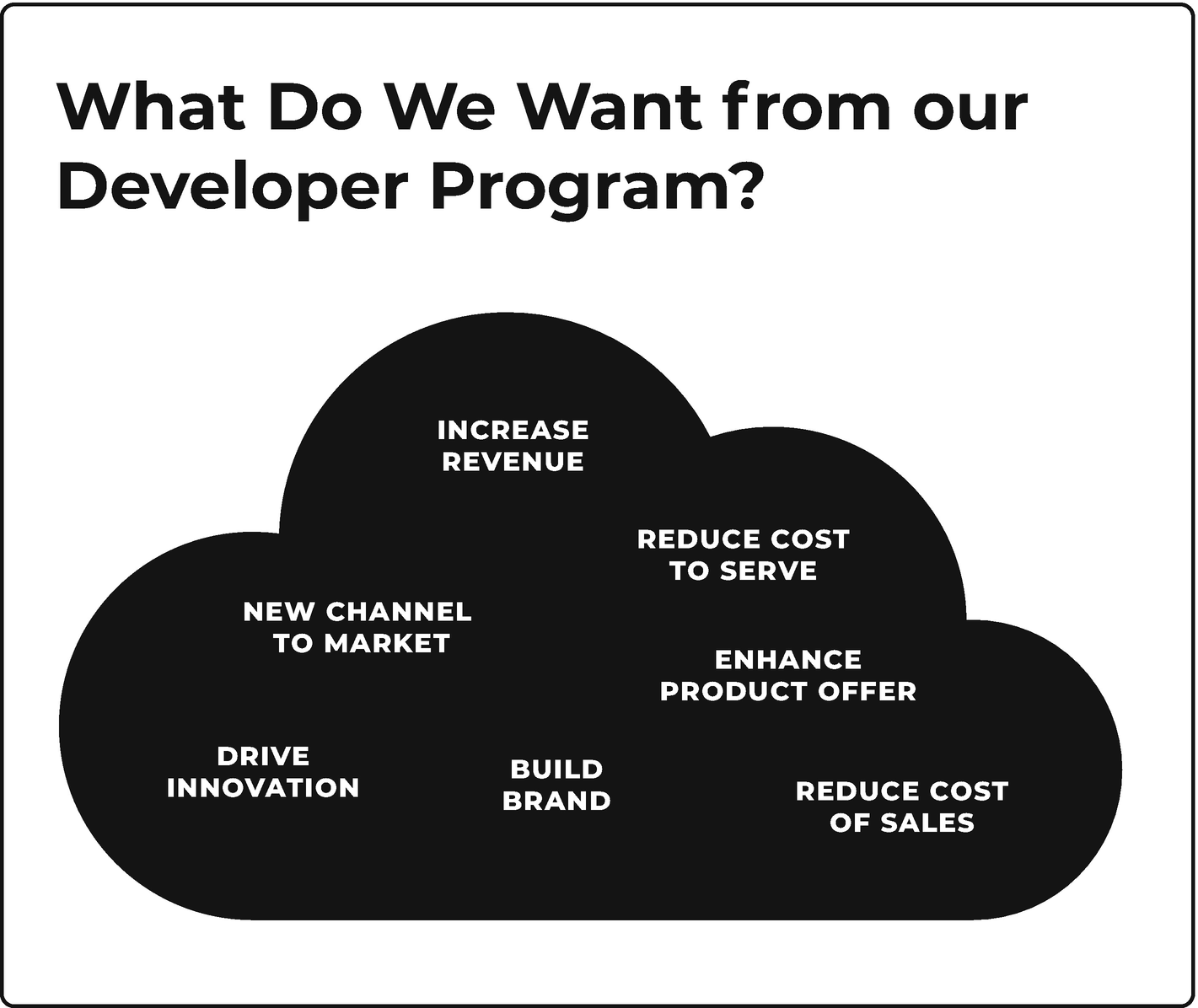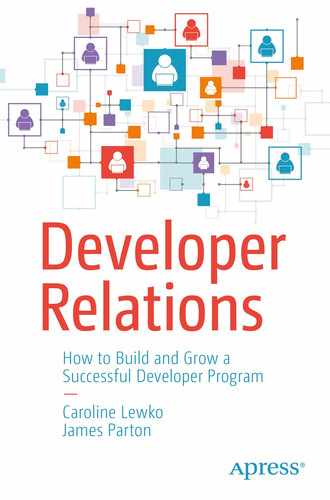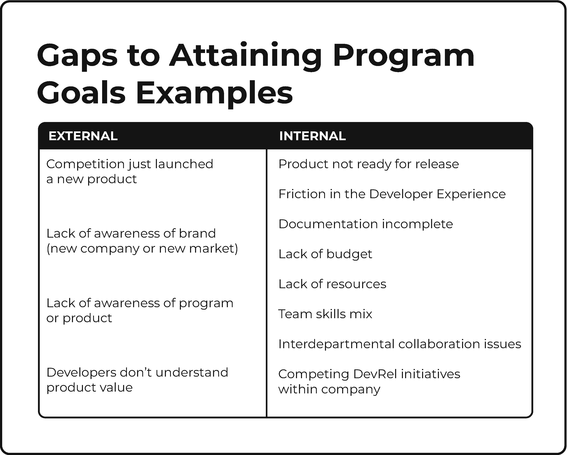You’ve been chosen to lead your organization’s Developer Program. Congratulations! Starting something new is super exciting, and there is the desire to hit the ground running.
To recap, you’ve gained an understanding of Developer Relations, you’ve had a chance to learn about developers, and you have a good appreciation for the B2D approach. You have a critical opinion of the product you are supporting and its value proposition to developers. You have secured the backing of the executive team, and you understand the relationship between your DevRel program and the high-level company goals.
OK, what’s first? Time for a hackathon! Right??
We’ve run into this scenario more times than we care to recall. That, or the one where you immediately rush to hire a developer advocate. Our response is always the same – slow down, where’s your plan?
Let’s look at the pieces you need to build a solid plan and set your program’s goals.
Setting Program Goals
What is the purpose of your developer program?
What do you want your developer program to achieve?
What value will it bring to your organization?
What value will it bring to the developers you want to serve?

What do we want from our developer program?
When I start with a new program, I always identify an ROI goal. I also review the product to understand the current state, understand the current developer journey and determine what needs to be improved.
Unfortunately, most companies hope for instant results from their DevRel Programs, not realizing that it’s a longer-term play of 3-5 years. They don’t invest that long and thus have problems with gaining momentum and adoption. I’ve definitely seen this in product launches, where too many promises are made, upgrades are not backward compatible, or the product is too quickly moved to end of life. This breaks trust with developers, which is very hard to rebuild. There is also a push to chase new developers, but what’s really needed is the increase in nurturing the current community that has tremendous value to give.
—Suzanne Nguyen
Senior Director, Brand and Communications, Angora
Formerly DevRel at Samsung, Immersion, T-Mobile, Adobe, Sun
Long-Term Program Goals
You’ll want to have one or two long-term goals , something to strive for over the course of two to five years. Sometimes, these are called top-line goals. We recognize that your corporate culture might dictate whether those goals are practical or grandiose. The big striving goals are sometimes called BHAGs, or Big Hairy Audacious Goals – think of NASA striving to put a person on Mars. The best BHAGs require building for the long term and exude a relentless sense of urgency. In a more practical business context, that motivation may come from overtaking a rival or by disrupting a market that is stale and starved of innovation.
Long-term goals are often driven or at least influenced by corporate goals. If you are a startup, one of your long-term goals might be contributing toward a corporate transaction like an investment, acquisition, or an IPO. In a Developer Plus company, the goals might be to support an overarching innovation agenda or a new product strategy.
Short-Term Program Goals
To contribute to the company’s revenue by growing the size and reach of our program
To increase our reputation with developers and/or become a thought leader in our field
To remove the friction in our Developer Experience
To lower our support costs while improving the support experience
To improve and speed up the feedback loop for product enhancements and new product development
To gain knowledge and expertise in running a developer program
At this point in your planning, focus on nailing down your long term and short term program goals. These will give you and your team direction, and your stakeholders the confidence in your plans.
Some of your goals may also be very specific to the situation of your program. For instance, your goal might be to establish your team with its own budget, if you have a brand-new program. Or you may wish to improve the level of recognition your developer program receives within your company .
It’s always best to focus on a tight set of three to four goals; any more and you will be spread too thinly and lack focus. As well, at least one of your goals must contribute to bringing value to the business either in revenue or other means.
Clarity and Realism in Goal Setting
More apps (popular in the early mobile days when device companies and operators just wanted more apps and often paid developers for them, to the detriment of the developer program trying to manage this and lowering the overall quality of submissions).
New ideas (it’s great to be creative, but without context this can just waste time and money).
Better partnerships (be careful about alienating current partnerships).
Someone to debug our code and fix our documentation (that’s just not nice).
More efficient employees (it’s not the job of Developer Relations).
Make us look innovative (it’s better to actually be innovative than look innovative).
Make a stakeholder look innovative (pet innovation projects are common with executives looking to curry favor for a promotion, and they often zero in on the latest thing).
We need to be more like Slack, or Twilio, or Uber or fill in the blank with the name of the current media darling.
Our company needs to undergo a digital transformation to boost our stock price.
Be careful what you are being asked to do, and aim to understand the intent and get clarity.
Metrics for Measuring Goals
Speaking of gaining clarity – we must make a short mention here on metrics. All goals should have a number and time period attached to them or some way to measure progress toward achieving them. Otherwise, how do you know if you have attained your goal? It’s great to say you want to grow your program, but it’s more effective to declare: we will grow our program to 500,000 developers by increasing the number of active developers by an average of 15% quarter on quarter for the next 12 months.
Knowing how to identify the best metrics in which to measure and monitor your goals can be challenging, as there is no shortage of things to measure. We’ll do a deeper dive on setting program metrics in Chapter 26.
Influences and Gaps
Many programs we’ve seen can be solely focused on a number to hit they fail to review their goals in the wider context or consider what might influence their goals. These influences will affect the scope of your goals, the tactics required to execute on them, and will have a direct influence on being able to achieve your goals.
Your role is to uncover these influences, determine the gaps between your current situation and your intended outcome, and then set your program plan accordingly. Use your strengths to overcome any weakness and grab the opportunities.
Identifying these influences and their scope will come from your own research and analysis. Tools helpful for reviewing your strengths and weaknesses include a SWOT1 analysis. Talking directly to your developers whether in direct conversations or surveys can uncover valuable information. And of course, reviewing your metrics when you finally have them.
Corporate goals
Number of products you must support
Number of staff on the DevRel team
Skill set of the DevRel team
Where DevRel sits in an organization
Whether you are a Dev First or Dev Plus company
The business and pricing models of the DevRel products
Is the Developer program a cost center or profit center
Timing of any corporate announcements or expectations
Geographical considerations, like product availability or localization
Age of your program
Status/age of your products (new to the market or sunsetting)
Status of competitive products
Your program budget
Gaps to Attaining Program Goals Examples
|
Program Goals and Gaps Example
|
Keep these influences in mind as you read the rest of the book and consider your own balance of variables. We’ll mention many times in the book that Developer Relations is not finite, so there is no “one” plan to rule all plans.
Summary
Program goals are a reflection of the overall company goals and a means to clarify the purpose and value your Developer Program will bring to your organization. At least one of your program goals should show how the developer program is contributing value to the business. There are a number of variables that affect your ability to create a plan for your Developer Program and to set your goals. Uncovering them and being mindful of the gaps will make your goals and tactics more realistic and achievable.


